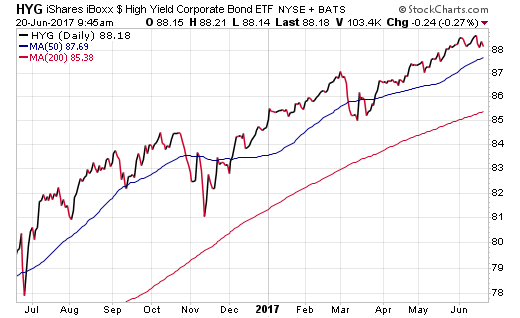Setting reasonable expectations for dividend income is an aspect of investing that many retirees have yet to embrace. With 10-Year Treasury yields hovering in the low two percent range, there is generally a need for other investment options to supplement high quality fixed-income. This is often when investors turn to exchange-traded funds that track a basket of riskier assets to generate the income they desire or to chase a top-performing market sector.
Some of the most heavily-trafficked high yield investment classes are junk bonds, preferred stocks, and REITs. These three areas have historically provided a much greater source of yield compared to stodgy investment-grade bonds, while creating opportunity for capital appreciation as well. This trend has proven so steady in recent years that the iShares US Preferred Stock (NYSE:PFF) and iShares iBoxx $ High Yield Corporate Bond ETF (HYG) have each accumulated over $18 billion in assets under management.

Yet, as prices of these ETFs rise, it’s become notable how much their yields have fallen in tandem. HYG now has a 30-day SEC yield of less than 5%, while PFF is quickly approaching that same marker. For investors who are used to 7-8% income streams for taking this level of credit or interest rate risk, the cupboard is becoming incrementally more barren with each passing day.
The options to remedy this situation are twofold: 1) accept a lower yield on assets with higher credit quality or 2) take on even more risk to hit a specific income target.
The next step up the income ladder is towards smaller, riskier securities or those who are using a form of leverage to boost returns. For example, the YieldShares High Income (NYSE:YYY) owns a basket of 30 closed-end funds to generate its 7.46% dividend yield. Most, if not all, of the underlying actively managed closed-end funds in the YYY portfolio use embedded leverage to boost their income streams. This allows the ETF to pass on those yields to shareholders in the form of hefty monthly dividends.
Master limited partnerships are another area of the market currently offering relatively high income as well. The Global X MLP (NYSE:MLPA) sports a yield of 7.58% based on its most recent quarterly dividend. This fund owns a basket of 24 underlying MLPs engaged in storage and transportation in the energy sector.
The reason these MLP-type funds sport such attractive yields is their direct link to the commodity space. The fall-off in oil and natural gas prices has resulted in greater volatility and/or price depreciation of energy sector funds. This causes the yields to rise as MLP prices fall.
Lastly, for those with the most aggressive risk tolerance or outright desire for speculation, there are direct leveraged plays on dividend indexes. These are the most daring and “use at your own risk” category of all the income-generating fund options.
The UBS E-TRACS Monthly Pay 2xLeveraged Mortgage REIT (NYSE:MORL) offers an astounding 17.23% yield. This fund is structured as an exchange-traded note, which allows the issuer to use some financial engineering to track a specific index using leverage. The end result is 2x magnified price action and dividends that is not for the faint of heart. These same leveraged indexes are also available for MLPs, small cap dividend stocks, and closed-end funds with double digit yields.
The Bottom Line
One adage that income investors must always heed is that there is no free lunch when it comes to yield. Every incremental step in additional income comes with an associated higher risk of invested capital. Therefore, it’s critical to carefully evaluate whether seeking out funds strictly for their yields is a sound long-term strategy or simply a one-dimensional opportunity with overlooked risks.
I always encourage income investors to approach their portfolio construction with a mix of high quality and high yield assets that complement each other. This barbell strategy can help offset varying risk dynamics and create greater diversification across multiple asset classes.
Disclosure: FMD Capital Management, its executives, and/or its clients June hold positions in the ETFs, mutual funds or any investment asset mentioned in this article. The commentary does not constitute individualized investment advice. The opinions offered herein are not personalized recommendations to buy, sell or hold securities. The views and opinions expressed herein are the views and opinions of the author and do not necessarily reflect those of Nasdaq, Inc.
